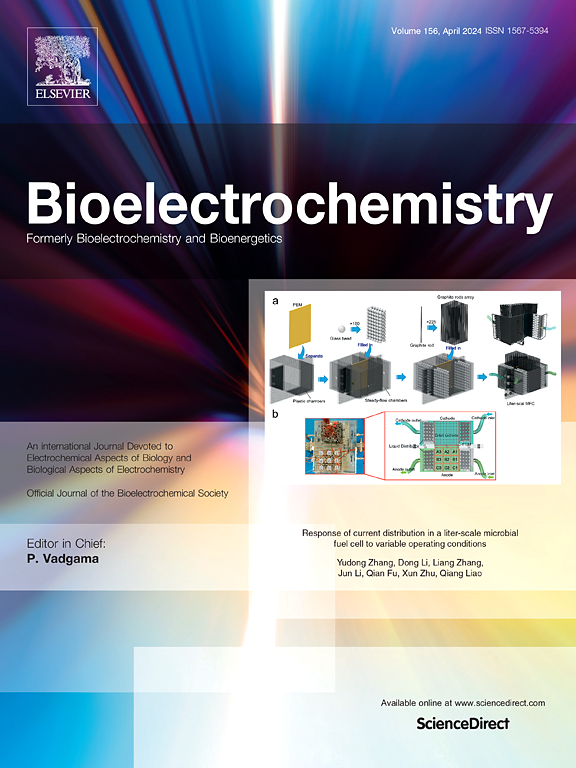体外电穿孔细胞释放金属副产物的旁观者效应
IF 4.8
2区 化学
Q1 BIOCHEMISTRY & MOLECULAR BIOLOGY
引用次数: 0
摘要
在电穿孔过程中,电极的溶解将金属离子释放到介质中,改变了电穿孔细胞的微环境,使金属离子能够穿透细胞膜。在细胞膜修复、稳态恢复或细胞死亡途径激活过程中,细胞从细胞质和细胞膜中清除多余的金属。本研究评估了电穿孔后金属副产物对体外未处理(非电穿孔)细胞的影响。CHO和HCT116细胞用三种脉冲方案电穿孔(单极:100 μs, 5 ms;双极:2 μs)采用铝或不锈钢电极。电穿孔后,将细胞转移到新鲜的生长培养基中并孵育2或4小时。孵育期间允许细胞恢复或激活细胞死亡途径,导致金属副产物在孵育培养基中积累。与铝电极或其他方案相比,采用5ms脉冲方案的不锈钢电极在培养介质中引起铁、铬和镍离子的显著增加。培养介质中的金属离子对非电穿孔细胞产生毒性,破坏细胞周期功能或诱导细胞死亡。观察到的毒性是由于金属离子对细胞功能的综合影响以及细胞用来保护自己免受金属过载的机制造成的。本文章由计算机程序翻译,如有差异,请以英文原文为准。
Bystander effect of metal byproducts released from electroporated cells after electroporation in vitro
Electrodes dissolution during electroporation releases metal ions into the medium, altering the microenvironment of electroporated cells and allowing metal ions to penetrate cell membrane. During cell membrane repair, homeostasis restoration or activation of cell death pathways, cells eliminate excess metals from the cytoplasm and membrane. This study assessed the effects of post-electroporation metal byproducts on untreated (non-electroporated) cells in vitro.
CHO and HCT116 cells were electroporated with three pulse protocols (unipolar: 100 μs, 5 ms; bipolar: 2 μs) using either aluminum or stainless-steel electrodes. After electroporation, cells were transferred to fresh growth medium and incubated for 2 or 4 h. Incubation period allowed either cell recovery or the activation of cell death pathways, leading to the accumulation of metal byproducts in the incubation medium.
Stainless-steel electrodes with the 5 ms pulse protocol caused a considerable increase in iron, chromium and nickel ions in incubation medium compared to aluminum electrodes or other protocols. Metal ions in incubation medium caused toxicity in non-electroporated cells, disrupting cell cycle function or inducing cell death. The observed toxicity results from combined effects of metal ions on cellular functions and the mechanisms the cells use to protect themselves from metal overload.
求助全文
通过发布文献求助,成功后即可免费获取论文全文。
去求助
来源期刊

Bioelectrochemistry
生物-电化学
CiteScore
9.10
自引率
6.00%
发文量
238
审稿时长
38 days
期刊介绍:
An International Journal Devoted to Electrochemical Aspects of Biology and Biological Aspects of Electrochemistry
Bioelectrochemistry is an international journal devoted to electrochemical principles in biology and biological aspects of electrochemistry. It publishes experimental and theoretical papers dealing with the electrochemical aspects of:
• Electrified interfaces (electric double layers, adsorption, electron transfer, protein electrochemistry, basic principles of biosensors, biosensor interfaces and bio-nanosensor design and construction.
• Electric and magnetic field effects (field-dependent processes, field interactions with molecules, intramolecular field effects, sensory systems for electric and magnetic fields, molecular and cellular mechanisms)
• Bioenergetics and signal transduction (energy conversion, photosynthetic and visual membranes)
• Biomembranes and model membranes (thermodynamics and mechanics, membrane transport, electroporation, fusion and insertion)
• Electrochemical applications in medicine and biotechnology (drug delivery and gene transfer to cells and tissues, iontophoresis, skin electroporation, injury and repair).
• Organization and use of arrays in-vitro and in-vivo, including as part of feedback control.
• Electrochemical interrogation of biofilms as generated by microorganisms and tissue reaction associated with medical implants.
 求助内容:
求助内容: 应助结果提醒方式:
应助结果提醒方式:


